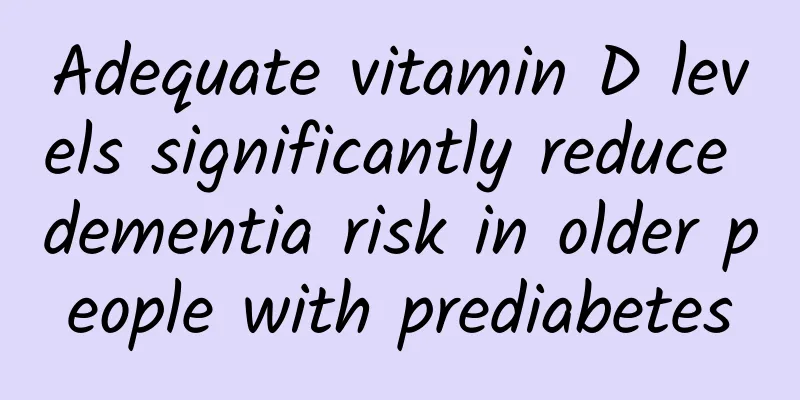Adequate vitamin D levels significantly reduce dementia risk in older people with prediabetes

|
Prediabetes is defined as a state in which blood glucose concentrations are above normal but below the threshold for diabetes. It is estimated that by 2030, 470 million adults worldwide will be in prediabetes. **Prediabetes patients are not only at increased risk of diabetes, but also at significantly increased risk of dementia. **With the aging of the population, dementia has received increasing attention due to its increasing disease burden and high medical costs. Therefore, it is of great clinical and public health significance to clarify the modifiable risk factors for dementia in people with prediabetes and to strengthen early identification and early prevention of high-risk groups. In recent years, the role of a reasonable diet and a healthy lifestyle in preventing dementia has received widespread attention. Vitamin D is a common trace vitamin that is mainly derived from sunlight exposure and dietary intake. In recent years, studies have found that vitamin D plays an important role in reducing neuroinflammation, maintaining the normal physiological function of brain tissue blood vessels, and improving cellular antioxidant capacity. At the same time, genetic polymorphisms of vitamin D receptor (VDR) and vitamin D binding protein (VDBP) are also related to the regulation of the biological activity of vitamin D. However, to date, no study has systematically evaluated the association between serum 25-hydroxyvitamin D, VDR, and VDBP and dementia risk in elderly people with prediabetes. (The picture comes from the Internet, the copyright belongs to the original author) In response to the above problems, researchers from the National Clinical Research Center for Kidney Diseases, Nanfang Hospital, Southern Medical University, recently published a research paper titled "Serum 25-Hydroxyvitamin D, Vitamin D Receptor, and Vitamin-D-Binding Protein Gene Polymorphisms and Risk of Dementia Among Older Adults With Prediabetes" in the Journals of Gerontology Series A-biological Sciences And Medical Sciences. **The study found that the higher the serum 25-hydroxyvitamin D level in the elderly with prediabetes, the lower the risk of dementia; in carriers of the VDR rs7975232 AA allele, there is a stronger negative correlation between the two. **Professor Qin Xianhui of the Department of Nephrology, Nanfang Hospital, Southern Medical University is the corresponding author of the article, and Dr. Zhou Chun is the first author. The study included 34,237 elderly prediabetic participants without dementia at baseline, with an average age of 64.5 years. The primary endpoint of the study was new-onset all-cause dementia, and secondary endpoints included new-onset Alzheimer's disease and new-onset vascular dementia. The mean serum 25-hydroxyvitamin D concentration was 48.8 (SD: 20.5) nmol/L. After about 12 years of follow-up, 941 participants developed all-cause dementia, including 390 participants who developed Alzheimer's disease and 229 participants who developed vascular dementia. Overall, serum 25-hydroxyvitamin D levels were significantly negatively correlated with the risk of dementia . For every 20.5 nmol/L (1 standard deviation) increase in serum 25-hydroxyvitamin D levels, the risk of all-cause dementia was significantly reduced by 18% (Figure 1A), the risk of Alzheimer's disease was significantly reduced by 17% (Figure 1B), and the risk of vascular dementia was reduced by 14% (Figure 1C). Figure 1. Correlation between serum 25-hydroxyvitamin D and all-cause dementia (A), Alzheimer's disease (B) and vascular dementia (C) in elderly patients with prediabetes. More importantly, in non-carriers of the VDR rs7975232 C allele, there was a stronger negative correlation between serum 25-hydroxyvitamin D and the risk of all-cause dementia. For every 20.5 nmol/L (1 standard deviation) increase in serum 25-hydroxyvitamin D, the risk of all-cause dementia decreased by 31% (Figure 2). Figure 2. Effects of APOE ε4 (A) and VDR gene polymorphism (B) on the association between serum 25-hydroxyvitamin D and all-cause dementia risk in elderly people with prediabetes. The results of this study showed that the higher the serum 25-hydroxyvitamin D level in the elderly with prediabetes, the lower the risk of dementia; the effect of vitamin D was more obvious in carriers of the VDR rs7975232 AA allele. This study emphasizes the importance of maintaining adequate serum 25-hydroxyvitamin D levels for preventing the risk of dementia in elderly people with prediabetes. References: Zhou C, Gan X, Ye Z, Zhang Y, Yang S, He P, Zhang Y, Liu M, Wu Q, Qin glae015. Editor | Wu Yiting Xiang Hao Audit | Qin Xianhui |
<<: Small red bumps on the skin could be cancer?
Recommend
What medicine should I take if my menstruation doesn't stop?
In physiology, some girls suffer from irregular m...
Learn to "massage the spleen meridian" to lay a good foundation for your health!
In traditional Chinese medicine theory, the splee...
Will my period be delayed?
Menstruation is cyclical and regular. Late menstr...
What are the benefits of eating guava? Can you eat guava during menstruation?
Guava fruit has spherical, oval, ovoid and pear-s...
Be careful when eating seafood! There is no cure, you may also be poisoned by this seafood
Expert in this article: Li Lin, PhD in Food Scien...
What tests should women do for breast pain
The phenomenon of breast pain is a huge threat to...
Is it okay for women to soak their feet during menstruation?
Regular foot soaking is of great benefit to the b...
Is it good to have too much pubic hair?
When it comes to the topic of pubic hair, I belie...
What causes abdominal pain after childbirth?
There are many adverse conditions in women's ...
What should I eat instead of eating when I am more than 5 months pregnant? What should I pay attention to when I am more than 5 months pregnant?
We all know that after a woman becomes pregnant, ...
What kind of purple rice is good? How to make purple rice bread
Purple rice is a kind of food that we use widely ...
Vulvar furuncle
I believe that many people do not know the cause ...
What is the reason for a little blood in the leucorrhea?
If female friends do not pay more attention to co...
Hot topic! Does milk tea really taste better if it is bottled in a "three-grade tube"?
Milk tea shops are doing things again. Have you n...
![[Creative Cultivation Program] Can spinach help treat osteoarthritis? It's true, but the method is a bit magical](/upload/images/67f1c1731659c.webp)








